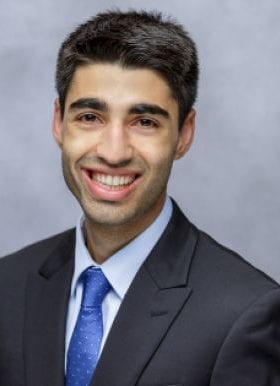Skip to content
Skip to search
Skip to footer

Arjun Tambe, MD
What drew you to WashU?
- Overall: I felt that WashU is the best balanced of the top IM programs – academic strength / clinical opportunities, a strong hospital system, a truly diverse patient population (racially and socioeconomically), a good culture (co-residents, ancillary staff, etc.), work-life balance, and things to do nearby when you’re off.
- Academic: a very strong IM program (smart attendings and co-residents, great fellowships here and strong fellowship match, tons of research, top med school- the usual metrics), but also has opportunities for specific interests. I like teaching/mentoring, and was particularly interested in the WUTPP program and leadership pathway. There are several other pathways too.
- Wellness: 4+2+2 schedule ensures that you don’t have several consecutive heavy rotations. Good work-life balance compared to other top IM programs. Minimal 24h call (just a few days per year) keeps your circadian rhythm happy but gives you the experience of doing it. 5 personal days per year. Half-days off on clinic and elective blocks. Lunch provided on multiple days per week. Resident lounge and workout room in the department of medicine. Co-residents are smart but still down-to-earth, genuine, and great friends. Accessibility to recreational activities close to the hospital.
- Clinic: You are truly the PCP of your clinic patients. You have MAs, resource nurses, pharmacists, diabetes educators, etc. to help you in clinic (and they are so nice and helpful). They will assist with faxes, prior auths, scheduling, etc. to help you focus on the medicine. I have a diverse mix of patients – young, middle-aged, old, healthy, uncontrolled, urban, rural, well-off, underserved.
- Hospital system and facilities: Barnes has been on the US News best hospitals honor roll for years. It has a huge catchment area – if you’re sick enough within a few hundred miles, you end up here. In the ICU, you’ll get patients transferred in from hours away (or shorter if they get choppered in). The EMR is Epic. The buildings/facilities are nice and constantly undergoing improvement to keep them nice. All of the buildings are connected by links (internal bridges, like the Minneapolis skyway), which are convenient and give some nice views. The ancillary staff helps you as a resident and minimizes “scut-work.”
- Patient population: both socioeconomically and racially diverse. You will see well-off patients, and you will have opportunities to help patients who have barriers to care. With our large catchment area, we pull underserved patients from both urban and rural settings, which I feel is rather unique.
- 2 sites: most time at Barnes-Jewish Hospital (i.e. the main WashU teaching hospital), with a smaller amount of time at the VA. This gives diversity in clinical training without being spread too thin.
- Financial: good cost of living means that you can have a good place to live in and still go out to dinner, etc. when you’re off. We have moonlighting opportunities.
- COVID response: in the early days when COVID was especially new and scary, residents were protected from seeing COVID patients for several months. Program leadership advocated for the residents.
What is your favorite part about living in St. Louis?
- I came to St. Louis from Chicago. St. Louis is of course smaller, but it’s much more accessible, easy to get around, has great food/drink options, and has the other recreational activities that you’d expect in a major city (musical theater, parks, bars, Costco).
- The hospital is in a really nice area (Central West End). I like minimizing my commute, so I live right by the hospital. But I’m in the CWE, right by bars, restaurants, and of course the amazing Forest Park. Forest Park is huge and has nature things (forested, wetlands, etc.), biking/running trails, boating, golf courses, the zoo, a theater, the science center, a greenhouse, tennis courts, and countless other activities. How many urban hospitals have a giant park right across the street?
- Most co-residents live in a few neighborhoods, meaning that you’re right by your friends when you have a day off and want to play tennis, grab a drink, or chill at someone’s place.
- St. Louis is driving- and parking-friendly, meaning that even if you’re not right next to something, it’s a simple ~10 minute drive. I haven’t had any issues with traffic.
Related
